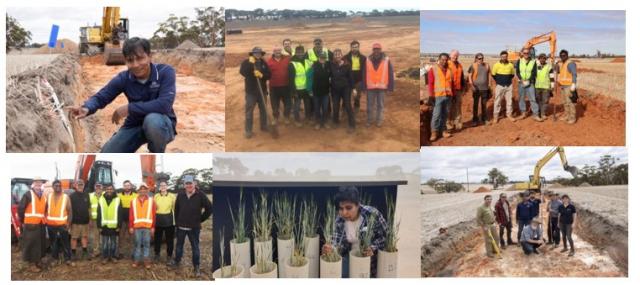Meet the team re-engineering soils
GRDC code
DAW1902-003RTX
Current soil amelioration methods (liming, clay spreading, delving, deep ripping, deep soil mixing, soil inversion) address constraints up to 30-40cm deep.
Enhancing soil profiles yields enduring productivity benefits.
Sandplain soils cover 50 per cent of South-West WA's agricultural lands (12 million hectares).
Deep sands suffer low water/nutrient storage, acidification, compaction, and erosion.
Sandy duplex soils are more complex, with A-horizons such as deep sands, while B-horizons can be dense, poorly structured, sodic, alkaline, chemically toxic, and prone to waterlogging.
Managing these diverse constraints is challenging, and responses to costly soil management are inconsistent.
The re-engineering team within the Soil Science and Crop Nutrition portfolio is assessing the implementation and interaction of soil amelioration and amendment practices to ensure that they provide the greatest benefit for the longest possible time.
Researchers are tailoring amelioration strategies for specific soil types, soil depths, constraint types and environmental interactions.
Dr Gaus Azam, Principal Research Scientist, leads this team within the portfolio.
Originally, he established a long-term field experiment in a cropping paddock near Kalannie in the WA Wheatbelt, to understand the effect of different amelioration treatments on soil that was continuously cropped.
In this trial, crop yield and water use efficiency were doubled.
So, a new Blue Sky soil management project was initiated that is called ‘Re-engineering Soils.'
This was possible with support from the Grains Research and Development Corporation (code DAW1902-003RTX)
It involves laboratory, glasshouse and field-based experiments to address multiple interacting soil constraints in the crop root zone through combining innovative soil amelioration techniques and soil profile reengineering.
The main question being asked is: How would the roots of wheat and barley respond to the different treatments?
Gaus’s team found that when the soil constraints were not ameliorated, wheat and barley roots grew to just over 20cm deeper, compared to 80cm deep root system in the re-engineered soils, while research also uncovered root growth patterns resulted in how the crops used water and this in turn determined the yield of the crops.
The project team consist of several extremely talented soil scientists, including Chad Reynolds (Senior Research Scientist), Bindi Isbister (Research Scientist), Kanch Wickramarachchi (Research Scientist), Dr Hasin Rahman (Research Scientist), Dr Shahin Rahman (Research Scientist), Glenn McDonald (Senior Research Scientist) and David Hall (Principal Research Scientist).
So far, the Re-engineering team has conducted near 50 laboratory, glasshouse and field-based experiments including 12 soil profile re-engineering experiments.
All field-based experiments are distributed across the soil type and different rainfall regions within the grain belt of WA.
The team is also backed by several other researchers, including Portfolio Manager Chris Gazey, Principal Research Scientist Dr Steve Davies, Principal Research Scientist Dr Craig Scanlan, Senior Research Scientist Wayne Parker, Research Scientist Alice Butler, Senior Research Scientist Glen Riethmuller and Senior Research Scientist Tom Edwards.
As well as the technical team, consisting of Jo Walker, Steve Rossi, Trey Beeson, Grey Poulish and Sam Richards.
Gaus, along with other researchers Kanch Wickramarachchi and Dr Shahin Rahman, has recently published a Book Chapter on strategic tillage for sustaining the productivity of broadacre cropping in the arid and semi-arid regions of southern Australia.
Contact
Dr Gaus Azam
DPIRD Principal Research Scientist
E: Gaus.Azam@dpird.wa.gov.au

